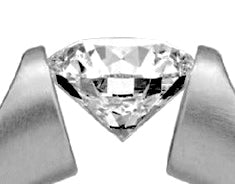Types Of Stone Settings
Ever wondered how a gemstone is set in a metal? Stone setting is an art where the gemstones are securely attached or set in a metal casing. There are popular types of stone setting which enhances the excellence of a gemstone along with its other features such as the cut, lucidity and color.
Prong/Claw Setting

This is the most common and popular type of stone setting. It is a claw shaped type of binding from top, while having a basket shape formation beneath. The basket can be any shape depending on the jewelry maker. See two of the basket shape examples below.


Three or more prongs wrap around the stone to keep the gemstone secured.
This setting also has a variation where instead of claws, a v-shaped prong is used to hold a part of gem. Refer image below to see the V-shaped prong.

This setting covers the gemstones least, allowing maximum light to pass through, resulting in maximum sparkle of the gemstone. Perfect setting for solitaires!
Bezel Setting

In Bezel setting the metal is run along the edges of gemstone covering the gemstone either fully or partially. This way the gemstones are well protected but in this type of setting the sparkle of a gemstone is not enhanced.


As this method of setting completely secures the stone edges, it is mostly used for most fragile gemstones.
This setting is very popular for men’s jewelry.
Pave Setting
Pave setting is derived from the French word paved or cobblestoned, meaning ‘pavement’. Small gemstones are set together on a surface in a patterned arrangement or in a grid format, with least metal visible between each stone. Tiny holes are created very close to each other on the metal surface of jewelry, where these stones are set.
Channel Setting

As the name suggests a gemstone is set in a channel made from two metal strips, in between which the gemstones are set, with edges fully secured by the two surrounding channels. The gemstones are more secured than bezel or prong types. It’s very popular as engagement or wedding rings, as it reflects maximum amount of light in this kind of setting, due to no metal obstruction between the gemstones. The disadvantage with channel setting is to clean the gemstone, tricky to repair and resizing the gemstone is unlikely.
Bar Setting

Its similar to channel setting. The only difference being, thin metal bars are placed in between the gemstones to hold them in place. This kind of setting however is only ideal for gemstones which are very hard.
Unlike the channel setting the sides of the gemstone lay exposed.
Invisible Setting
The setting of the gemstone is not made prominent unlike the prong or bezel settings. The gemstones are placed into griddles of a metal. The gemstones have channels cut in their base to fit onto the framework of the metal.
This kind of setting is used only when multiple stones are required to be set in a jewelry piece, with nearly no space in between any two gemstones once set. Hence most suitable for the gemstones cut with straight edges (cuts such as emerald cut, baguette cut) which can be placed very close to each other, edge to edge without leaving any gaps in between.
Flush/Burnish Setting

In Flush setting the gemstone is set inside a hole drilled in to the metal. This hole is slightly smaller in size than the gemstone. Metal is hammered around the gemstone to keep it secured, allowing zero movement of the stone. The gemstones sit either even or slightly below the metal surface of the jewelry, making only the top surface of gemstone visible.
It’s a very popular setting for modern day wedding bands.
Tension Setting


The gemstones are set in place by pressure exerted by the spring loaded metal. Groves like shelf made in the inner surface of metal supports the gemstone. This setting not only requires hard stones to be used which can sustain the pressure of the metal but also stronger metals which can create adequate pressure to hold the stone in place.
This type of setting are used in modern and unique rings.
Bead Setting

The gemstone is set in the metal using gravers which are tiny chisels. A concave depression, the size of the gemstone is made on the metal surface using ball burr. The stone is set into this depression with small pieces of metal on the edges of the stone using gravers. Later, a beaded tool is used to give finishing touch which now looks like a bead. This type of setting is one of the traditional way of setting.

